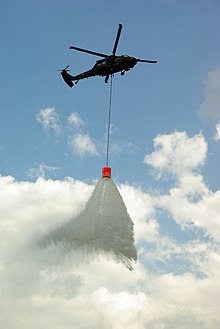Extinguishing water external load container for helicopters
Extinguishing water external load containers for helicopters are containers for holding extinguishing agents that are carried under the fuselage by a helicopter . They are used for fire fighting (. Eg mountains) in confined spaces and in open field and forest fires . When fighting fires from the air, the extinguishing agent (usually water ) is specifically targeted at the fire .
The external load container has a bottom valve which is opened from the helicopter either by means of a cable pull , via a compressed air line (e.g. with the Smoky type) or via an electrical control signal (e.g. with the Bambi Bucket or Semat). The water is usually absorbed from open water, but it can also be done by ground forces (so-called flight assistants) directly from fire engines (e.g. tank fire engines ) with the help of hoses .
Fixed container
In 1979, as a result of the heather fire of 1975, the German state of Lower Saxony published Technical Instructions No. 6 “Extinguishing water external load containers for helicopters” . It describes two types of container: Container I has a capacity of at least 800 liters and a total weight of a maximum of 1000 kg, Container II holds at least 5000 l and weighs a maximum of 5500 kg. A water depth of 1.2 or 2 m is required for optimal filling. They can be emptied within ten seconds.
In Bavaria, 900-liter containers are widespread and are housed at 18 different fire departments. In addition, there are another four extinguishing water external load containers with a capacity of 5000 liters available. Other federal states mainly use the large containers (e.g. 3000 or 5000 l), which are usually stored centrally.
Containers with a capacity of less than 1000 liters can be used with light multi-purpose helicopters such as police or rescue helicopters (e.g. Bell UH-1 , Eurocopter EC 135 , MBB / Kawasaki BK 117 ). For the heavier variants up to 5000 liters, medium-sized transport helicopters are required, which are mainly used by the military, such as the Sikorsky CH-53 or Super Puma types .
Foldable container (Bambi Bucket / Monsoon Bucket)
The system invented by Don Arney has been sold by SEI Industries in Canada since 1983 under the product name Bambi Bucket . In the Australian-New Zealand area, A-Flex Technology developed a comparable product with the Monsoon Bucket . The container is particularly suitable for use in inaccessible areas, as it can be filled in a variety of ways.
The main advantages of collapsible containers are the lower empty weight and the lower water depth (30 cm) required for filling. The container can also hold extinguishing foam , as the material has also been improved in terms of resistance. A disadvantage is the lack of robustness compared to the aluminum containers. As a rule, it is also not possible to generate a spray jet with the collapsible containers , which has an increased extinguishing effect and greater surface coverage (see photos: Bambi Bucket point drop above, Semat spray jet below). The reason is that a continuously opening outlet or a baffle plate that distributes the water is missing. This also means that the container can only be flown completely full or empty and not with partial amounts of water. The latter, however, would be an advantage as an adaptation to the changing fuel quantity and thus the MTOW , especially in the case of smaller helicopters. There are currently more than twenty different sizes with a capacity of 270 to 10,600 liters.
Web links
Individual evidence
- ^ Bavarian State Ministry of the Interior, for Building and Transport; State Fire Brigade School Würzburg; Mountain Rescue Bavaria; Flight assistant Bavaria: guidelines for cooperation between fire brigade and aircraft operators in Bavaria. (PDF; 1.2 MB) Leaflet for the fire brigades in Bavaria. In: feuerwehr-lernbar.bayern. State Fire Brigade School Würzburg, October 2017, p. 52 , accessed on June 10, 2020 .



